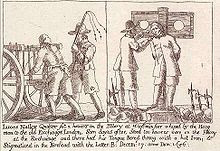https://www.bloomfield.ie/hellfire-back-raises-over-e8500-for-bloomfield-residents/
We helped out with Bloomfield hospital hike and worked in as part of a Community Special Interest badge for our scouts. We learned a bit about mental illness, Bloomfield hospital, the Quakers and also about Montpelier hill and the Hellfire club history
The Hellfire Clubs were founded in the eighteenth century, and were typically comprised of young aristocrats with a shared interest in drinking, debauchery and gambling. The first Hellfire Club was founded in England in 1719, but it was suppressed by order of King George 1st. The Irish Hellfire Club was founded in the 1730s, meeting in Dublin centre at first. One story has it that the Hellfire Club was banned from meetings in Dublin centre and started meeting in the hunting lodge or nearby Kilakee house.
The Irish Hellfire Club members were some of the elite of society, and included peers of the realm, high ranking army officers as well as wealthy gentlemen and artists. Founded by Richard Parsons (1st Earl of Rosse and founder of the first Irish Lodge of Freemasons,) and Colonel Jack St Leger (The son of a rich landowner from Kildare, notorious for gambling large amounts of money on ridiculous wagers.) Some of the Hellfire Club members or "Bucks" were violent. Henry Barry, Lord Santry, 1720-1751 was a known drunkard and he was feared in Dublin for his unpredictable rage and his apparent immunity to prosecution, as he was known to routinely bribe witnesses. He escaped trial until he killed Laughlin Murphy in 1938. He was sentenced to death but given a royal pardon and exiled to Nottingham.
The Club had largely broken up by the early 1740s and disbanded in 1760s but started again 1771 and ran until 1798ish. Richard Chappell Whaley was another violent character. His nickname was ‘Burn-Chapel’ Whaley because of his hatred of religion and in particular, the Roman Catholic church. He would amuse himself on Sundays by riding around Dublin setting fire to the thatched roofs of Catholic chapels.
https://www.abartaheritage.ie/
The Hellfire Club dig in 2016 . . . free digital publication Sacred Skies and Earthly Sinners.
- The excavation found that the mound at the rear of the Hellfire Club does indeed represent the badly damaged remains of a Neolithic passage tomb.
- The dig proved that the mound represented the remains of a stone cairn.
- We can also definitively demonstrate that the tomb had been very badly damaged by quarrying in the 18th and 19th centuries.
- We also found artefacts consistent with the Irish passage tomb tradition. These artefacts included megalithic art, a polished stone axehead, flint tools and a possible mushroom-headed bone pin.
- Charcoal samples from the excavation also dated the site to the middle Neolithic period.
During the research and analysis we also made a number of other interesting discoveries, such as the original name of Montpelier Hill, more on the history of the site and the true story of the infamous Hellfire Club themselves, as well as more on the folklore, myths and legends of this remarkable place.
Ballad 1926
At the bridge in Oldbawn in 1926
A Scotch road-making company their plant did erect
When the plant was constructed and ready for going
They sent out an order for lots of green stone.
Thomas Corcoran took the contract for stones to supply
At five shillings per ton, as they said they would buy.
So they all met together and each man agreed
As the price was alright they were badly in need.
So the work it began and the Quarries got light
They were quarrying and pounding and sledging all night.
So they just held a meeting one day on their own
to hire a borer to blast out the stone.
When the meeting came off they could not agree
The borer was taken over by a man named Tom Lee
He opened his Quarry on Mount Pelier Hill and hole after
hole it is there he did drill.
As the blasting began showers of spalls they came down
With the blasting and boring they shook Friarstown
And the likes of such stones you never have seen
That is now coming down from the Boring Machine.
During the blasting you'll quite understand
The stones they came down on Pat Grimes's land
When Pat saw the stones he said to Munroe:
"If I don't get compensation that borer must go!"
The company refused compensation to pay
So they went to law without further delay
When the law it was over it is pleasing to tell
Grimes got compensation and things went on well.
They are now as united as a King and Queen
Here's luck to Tom Lee and his boring machine.
Quaker Beginnings in England (from Wikipedia)
During and after the English Civil War (1642–1651) many dissenting Christian groups emerged, including the Seekers and others. A young man, George Fox, was dissatisfied with the teachings of the Church of England and nonconformists. He had a revelation that "there is one, even, Christ Jesus, who can speak to thy condition",[22] and became convinced that it was possible to have a direct experience of Christ without the aid of an ordained clergy. . . . he travelled around England, the Netherlands,[23] and Barbados[
In 1650, Fox was brought before the magistrates Gervase Bennet and Nathaniel Barton, on a charge of religious blasphemy. According to Fox's autobiography, Bennet "was the first that called us Quakers, because I bade them tremble at the word of the Lord".[22]:125 It is thought that Fox was referring to Isaiah 66:2 or Ezra 9:4. Thus, the name Quaker began as a way of ridiculing Fox's admonition, but became widely accepted and is used by some Quakers.[25] Quakers also described themselves using terms such as true Christianity, Saints, Children of the Light, and Friends of the Truth, reflecting terms used in the New Testament by members of the early Christian church.
Quakerism gained a considerable following in England and Wales, and the numbers increased to a peak of 60,000 in England and Wales by 1680[26] (1.15% of the population of England and Wales).[26] But the dominant discourse of Protestantism viewed the Quakers as a blasphemous challenge to social and political order,[27] leading to official persecution in England and Wales under the Quaker Act 1662 and the Conventicle Act 1664. This was relaxed after the Declaration of Indulgence (1687–88) and stopped under the Act of Toleration 1689.
The movement in its early days faced strong opposition and persecution, but it continued to expand across the British Isles and then in the Americas and Africa.
The Quakers, though few in numbers, have been influential in the history of reform. The colony of Pennsylvania was founded by William Penn in 1682, as a safe place for Quakers to live and practice their faith. Quakers have been a significant part of:
* the movements for the abolition of slavery,
* movements to promote equal rights for women, and peace.
* They have also promoted education and the humane treatment of prisoners and the mentally ill, through the founding or reforming of various institutions.
* Quaker entrepreneurs played a central role in forging the Industrial Revolution, especially in England and Pennsylvania.
Conscientious objection
During World War I and World War II, Friends' opposition to war was put to the test. Many Friends became conscientious objectors and some formed the Friends Ambulance Unit with the aim of co-operating with others to build up a new world rather than fighting to destroy the old, and the American Friends Service Committee. Birmingham, UK had a strong Quaker community during the war.[58] Many British Quakers were conscripted into the Non-Combatant Corps during both world wars.
| Religious Society of Friends orFriends Church | |
|---|---|
 Symbol used by Friends' service organizations since the late 19th century |
Famous Quakers
You may have heard of some of the following Quakers:
- George Fox – founder of Quakers, 1624–1691
- William Penn – friend of George Fox, founder of Pennsylvania, 1621–1670
- John Woolman – American Quaker involved in the abolition of slavery, 1720–1772
- John Dalton – British scientist who invented the atomic theory of matter, 1766–1844
- Edward Pease – first Quaker member of Parliament, 1767–1858
- Elizabeth Fry – British prison reformer, 1780–1845
- Joseph Rowntree – Chocolate manufacturer, 1837–1925
- George Cadbury – Chocolate manufacturer, 1839–1922
- Arthur Eddington – physicist, 1882–1944
- James Dean – actor, 1931–1955
- Jocelyn Bell Burnell – astronomer, discoverer of pulsars, born 1943
- Bonnie Raitt – musician, born 1949
- Tom Robinson – musician, born 1950
George Cadbury (19 September 1839 – 24 October 1922) was the third son of John Cadbury, a Quaker who founded Cadbury's cocoa and chocolate company in Britain.
Background[edit]
He worked at the school for adults on Sundays for no pay, despite only going to school himself until he was fifteen. [1] Together with his brother Richard he took over the family business in 1861. In 1878 they acquired 14 acres (57,000 m²) of land in open country, four miles (6 km) south of Birmingham, where they opened a new factory in 1879. He rented 'Woodbrooke' - a Georgian style mansion built by Josiah Mason, which he eventually bought in 1881.
In the early 20th century, he and John Wilhelm Rowntree established a Quaker study centre in the building,[2] and it remains the only such centre in Europe today, offering short educational courses on spiritual and social matters to Quakers and others. He also created a hospital in Normandy called "l'hopital de Normandy".
The Cadbury brothers were concerned with the quality of life of their employees and provided an alternative to grimy city life. As more land was acquired and the brothers moved the factory to a new country location, they decided to build a factory town (designed by architect William Alexander Harvey), which was not exclusive to the employees of the factory. This village became known as Bournville after the nearby river and French word for "town". The houses were never privately owned, and their value stayed low and affordable. Bournville was a marked change from the poor living conditions of the urban environment. Here, families had houses with yards, gardens, and fresh air. To the present, the town offers affordable housing.
The brothers cared for their employees; they both believed in the social rights of the workers and hence they installed canteens and sport grounds. Nineteen years after brother Richard died, George opened a works committee for each gender which discussed proposals for improving the firm. He also pressed ahead with other ideas, like an annuity, a deposit account and education facilities for every employee.
In 1901, disgusted by the imperialistic policy of the Balfour government and opposed to the Boer War, Cadbury bought the Daily News and used the paper to campaign for old age pensions and against the war and sweat-shop labour.[3]
George Cadbury was one of the prime movers in setting up The Birmingham Civic Society in 1918. Cadbury donated the Lickey Hills Country Park to the people of Birmingham. He also donated a large house in Northfield to the Birmingham Cripples Union that was used as a hospital from 1909. It is now called the Royal Orthopaedic Hospital.[4] In 1890 he, along with a number of other leading Quakers, helped re-establish Grove House School as Leighton Park School in Reading as the leading Quaker school in Britain.
He died at his home, Northfield Manor House, on 24 October 1922, aged 83.
Our services bridge both neurological and psychiatric disciplines and this joint approach is part of what sets us apart from other providers.





No comments:
Post a Comment